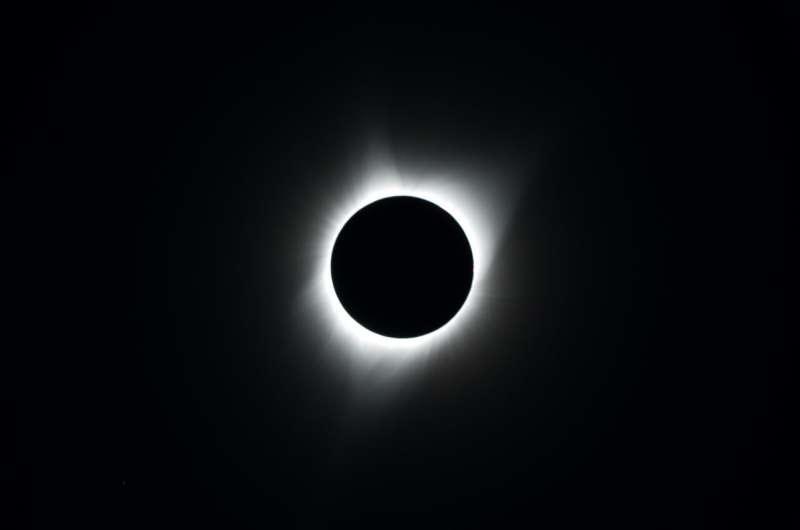This article has been reviewed according to Science X's editorial process and policies. Editors have highlighted the following attributes while ensuring the content's credibility:
fact-checked
trusted source
proofread
What to expect when total solar eclipse passes through Ohio

On April 8, millions of observers in Ohio will witness a total solar eclipse, a rare celestial event that promises to be an otherworldly experience.
Wayne Schlingman, director of the Arne Slettebak Planetarium at The Ohio State University, can still remember how momentous his first exposure to one was in 2017, when the last total solar eclipse to be visible in the United States swept a dark, narrow line across its coasts.
"I was not prepared for the emotional effect of seeing this wall of darkness coming at you," he said. "It was a phenomenal experience that I can't really put into words."
Eclipses once existed firmly in the realm of the unexplainable; in many cultures, they were perceived as a consequence of various myths and superstitions. Now we know they occur only when the Earth, the moon and the sun's paths are in perfect alignment.
"Our moon is fairly far from the Earth, and it's on a 5 degree tilt," said Schlingman. "But twice a year, when the moon has to cross the plane of the Earth's orbit, if it happens to be the right phase, an eclipse will happen."
Depending on the arrangement of the cosmos, the type of eclipse we can see from Earth also changes. Solar eclipses occur when the moon passes between the Earth and the sun, casting a shadow that blocks the sun's light from view on the ground, but lunar eclipses are the result of when the sun casts Earth's shadow onto the moon. In both cases, areas on Earth that fall within the range of complete coverage during these events are in the path of totality.
"Eclipses happen fairly regularly," Schlingman said. "It's just that the area that we would normally be able to see them in is relatively small in the case of solar eclipses."
Though Schlingman had before witnessed partial eclipses—misalignments where only parts of a celestial body are obscured or darkened—renewed curiosity about what to expect on the ground during a total eclipse led him to dig deeper into what all scientists can learn about the universe when the world around us goes dark.
A dark day
Unless you're a seasoned eclipse chaser, finding yourself underneath one can be a little daunting. Though April's total eclipse will take place around 3pm, as the moon's shadow moves over the Earth, the sky will darken as if it's night. And as the sun's light dims, the surrounding air will become noticeably cooler and nearby bugs and animals will likely fall silent.
If you're viewing the event from inside the path of totality, it's during this brief time that viewers can also temporarily remove their eclipse glasses. Most mysteriously, thin and wavy bands of light called shadow bands may also be seen faintly phasing in and out across the ground in the few minutes leading up to and after totality.
Regardless of how eerie these conditions may seem, an eclipse is a fascinating sight to behold, even more so because they provide unique opportunities for scientists to make important scientific discoveries, said Schlingman.
"By doing experiments on the ground, there's a lot of stuff that we can learn about our planet and even the sun during this time," he said. To date, researchers have used the phenomenon to decipher the structure of Earth's atmosphere, discover new elements, and reveal unknown details about the inner workings of our sun and the rest of the space environment.
But what sets 2024's eclipse apart from 2017's is that totality is expected to last about four minutes and 28 seconds, almost double the duration of the previous total solar eclipse.
This year's eclipse path is also much wider, causing it to pass over much more densely populated areas than its predecessor. This additional time and space will undoubtedly offer scientists a larger window for making more precise measurements about the eclipses' impacts and allow millions more onlookers to share in the delight.
"After seeing it, I instantly knew why people chase these things for the rest of their lives," said Schlingman. "There was no question in my mind, the total solar eclipse is just stunning."
Looking ahead
If you do miss this total solar eclipse, the next one to be visible in the contiguous U.S. won't occur until Aug. 24, 2044, and Ohio won't see another until 2099.
Nevertheless, that doesn't mean you can't mark your calendar to track other eye-opening astronomical events. According to Schlingman, stellar happenings like this one create amazing opportunities for people to engage with science on a different level than they'd normally be able to, and for younger generations, can open unexpected avenues to discover more about the aspects of the day that they're passionate about.
"If you're in Ohio, you should at least try to experience totality briefly, because this is literally in our backyard," he said. "It's something for everyone to be involved in, and hopefully someone else finds it as inspirational as I do."
Provided by The Ohio State University




















